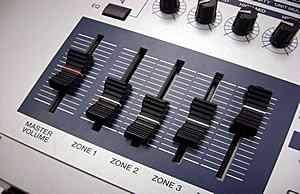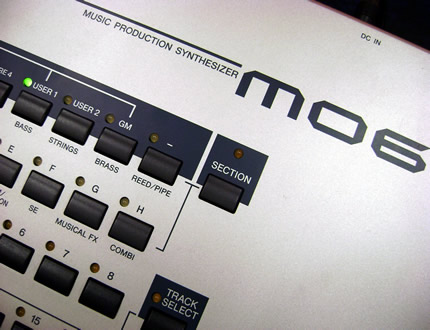
Introduction
At YamahaMusician.com, we rolled up our sleeves and reviewed the Yamaha MO6 and the Yamaha MO8 music production synthesizer. The MO6/MO8 impressed us with its expansive sound set, features, and sleek silver looks all at a reasonable price.
Overview
Like many of Yamaha's pro line synths, the heart of the Yamaha MO6/MO8 is the AWM2 (Advanced Wave Memory 2) tone generator. These keyboards come loaded with 175MB of waveforms and come in two flavors: 61-key synth-type and 88-key balanced hammer action. In addition, the MO6/MO8 has four assignable sliders and knobs, mod and pitch wheel, inputs for a foot controller and foot switch, 16-track sequencer, 64 voices of polyphony, over 500 preset programs, and over 1700 preset arpeggios. Plus, these synths have lots of tweakable and convenient features such as patterns, phrases, LFO's, envelopes, and 18 different filters you can play with. All of these features are navigated thru the brilliant 240x64 dot LCD backlit display. Did we mention that the MO6/MO8 comes standard with S/PDIF 24-bit digital outs too?
The Yamaha MO6/MO8 panel and menus closely resemble the S90ES's (Yamaha S90ES review) panel and menus. Plus, the sound banks, and sliders are very similar, so, if you are already familiar with that beast, you'll be at home with the MO in no time.
Keyboard Feel
The MO6's keyboard is your typical 61-key keyboard, while the MO8 is the 88-key balanced hammer weighted keyboard, felt very familiar to the great feeling S90ES keyboard. However, we were disappointed when we found out that the MO6/MO8 doesn't have aftertouch or an input for a breath controller. The Yamaha MO6 weighs in at 10.4kg (22lbs, 14oz) while the Yamaha MO8 weighs in at 21kg (46lbs, 3oz).
Sounds
The MO6/MO8 sound set is based on the Motif ES's sound set so, it rocks in this department. From sparkling bright to mellow acoustic and electric pianos, guitars complete with harmonics, fat string ensembles, synth leads, pads and crazy effects, the Yamaha MO6/MO8 will make your head dizzy with song ideas. In particular, we loved the sparkletin electric piano program—it inspired quite a few song ideas from us.
And, of course, the MO6/MO8 allows you to tweak and save your own sound creations—up to 256 of them plus 32 drum kits too. If that isn't enough room, you can save your programs to a USB drive and load them into the MO6/MO8's memory whenever you want.
Effects
The MO6/MO8's effects processor is also worth mentioning. The MO6/MO8 has over 190 different effects including 116 insertion effects. The insertion effects come in a set of two (A, B). In voice mode, one set can be applied; however, in performance, song, and pattern modes you can apply the insertion effects for up to three parts (i.e. three different MIDI channels). Once you have your insertion effects and routing set up, you can do some final overall tweaking by adding system effects (reverb and chorus, 69 types), master effects (8 types), and a pinch of master EQ to spice up the music.
Scene Capture and Patterns
The Yamaha MO6 and the Yamaha MO8 has a convenient feature called Song Scene which allows the user to capture up to five different snapshots (assignable using SF1-SF5 soft buttons) of sequencer track settings per song, such as, pan, volume, and mute settings for all your tracks. We found this great for previewing several different mix-down settings before committing to one.
Another feature we found that was really cool was Pattern Mode. Pattern Mode allows you to create riffs into individual elements and combine them with other patterns to create complex sequences easily. You can even use arpeggios to create your patterns.
Other Features
Among other great features we found on the MO6/MO8 was the Remote Control feature which allows you to control your DAW (digital audio workstation) with the MO's knobs and sliders, such as, play record, EQ, etc..., S/PDIF 24-bit 44.1 kHz digital outs, two USB ports—one for interfacing to a USB drive and the other for communicating to your DAW.
Conclusion
Overall, we were very pleased with the Yamaha MO6/MO8 music production synth. The preset sounds—pianos, guitars, bass, and, strings were awesome. We loved how tweakable everything was—the sliders, knobs, effects, filters, envelopes—this keyboard is a tweaker's paradise (pun intended). However, we were disappointed that Yamaha didn't design the MO6/MO8 with aftertouch or breath controller input, but, the fully-featured 16-track sequencer, assignable controllers, song scene, pattern, and DAW remote control features more than makes up for that.

